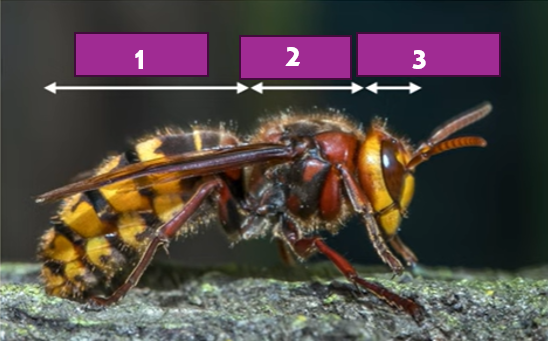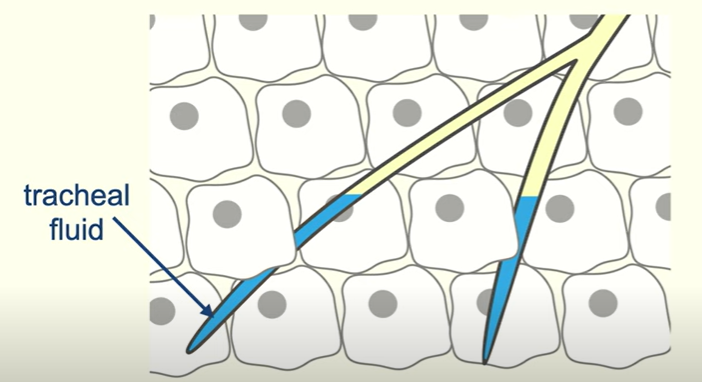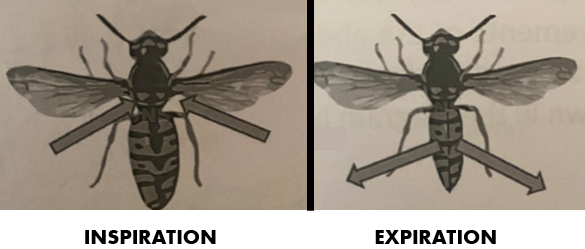Exchange surfaces part 5 [insects]
1/20
There's no tags or description
Looks like no tags are added yet.
Name | Mastery | Learn | Test | Matching | Spaced |
|---|
No study sessions yet.
21 Terms
what type of circulatory system do insects have?
open circulatory system
[blood is not in vessels but flows freely around the organs]
name of exchange surface of insects
tracheal system
[Instead of simple diffusion, insects use a tracheal system, which directly delivers oxygen to cells through tracheoles]
Why can't insects exchange gas with simple diffusion? (2)
-have a small SA:V. They cannot rely on diffusion alone.
-has exoskeleton that prevents gas exchange
structures of the insect gas exchange system(3)
spiracle
trachea
tracheoles

How are spiracle adapted for effective gas exchange?
-they open or close to control gas exchange and minimise water loss.
how are spiracles controlled?
They are opened and closed by valves
How are tracheoles adapted for effective gas exchange?
-thin walls→provides a short diffusion distance→increase rate of diffusion
-many tracheoles→ provides a large surface area→ provides more space for diffusion→ increase rate of diffusion
How are trachea adapted for effective gas exchange?
-has rings of chitin→ provides strength to prevent it from collapsing

label
abdomen
thorax
head

what is found at the end of tracheoles?
tracheal fluid

why are tracheoles not lined with chitin?
they are not lined with chitin so tracheoles are permeable, allowing gas exchange to occur
describe gas exchange in insects?
-Air enters the tracheae through the spiracles
-Tracheae branches into tracheoles
-oxygen dissolves in tracheal fluid and diffuses down concentration gradient from tracheoles into respiring cells
-carbon dioxide diffuses down concentration gradient out of respiring cells into the tracheoles to be released out of the spiracle
-Contraction of muscles in the tracheae allows mass movement of air in and out.
What happens if the insect has a low demand of oxygen [aka not flying/resting]? (2)
-spiracles close to reduce water loss
-ends of the tracheoles contain tracheal fluid which reduces surface area→ this decreases the rate of diffusion, reducing the uptake of oxygen
what happens if the insect has a high demand of oxygen [aka flight/ very active]?
-spiracles open to allows more air to enter and increases oxygen intake
-the insect may use anaerobic respiration→ this produces lactic acid, which reduces the water potential in the cells. Water leaves the tracheoles by osmosis (this reduces the amount of tracheal fluid at the ends of the tracheoles)→ so there will be a larger surface area for gas exchange→ this increases oxygen uptake
Describe the processes of inspiration and expiration in insect ventilation?
they ventilate by rhythmic movements of the abdomen.
Inspiration:
-muscles relax, causing the thorax and abdomen to expand.
-elastic recoil of the body helps return the thorax and abdomen to their original shape
-this increases the volume of the insect’s body
-this decreases pressure below atmospheric pressure so air is forced into the spiracles down the pressure gradient.
Expiration:
-muscles contract, pushing the abdomen down and in
-this flattens the body
-this decreases the volume of the insect’s body
-this increases pressure above atmospheric pressure so air is forced out through the spiracles down the pressure gradient.

other ventilation mechanisms (2)
-some have air sacs that inflate or deflate to ventilate the tracheal system (keep air moving through the insect’s body). They act as air reservoirs (store extra air), increasing the volume of air moved through the tracheal system.
-use wing movements to pump air to ventilate the tracheal system.
where are air sacs found?
trachea
Why do insects need lots of oxygen?
-they have a high metabolic rate→so they need a constant supply of oxygen for aerobic respiration. This produces the energy needed for movement
how do insects reduce water loss? (4)
-spiracles are closed as often as they can
-some spiracles have hairs to trap humid air
-exoskeleton is covered with a waterproof cuticle to help prevent water loss
-air sacs store air inside the body, reducing the need to keep spiracles open all the time. This helps minimize water loss
dissecting an insect
-fix the insect onto the dissection board using dissection pins
-carefully cut open the exoskeleton
-use a syringe to fill the abdomen with saline solution. You will see the thin, silvery tracheae.
-use a microscope to see the tracheae in detail. You will see the rings of chitin in the tracheae.
in dissection when injecting the solution, why is the tubes silver?
they are filled with air